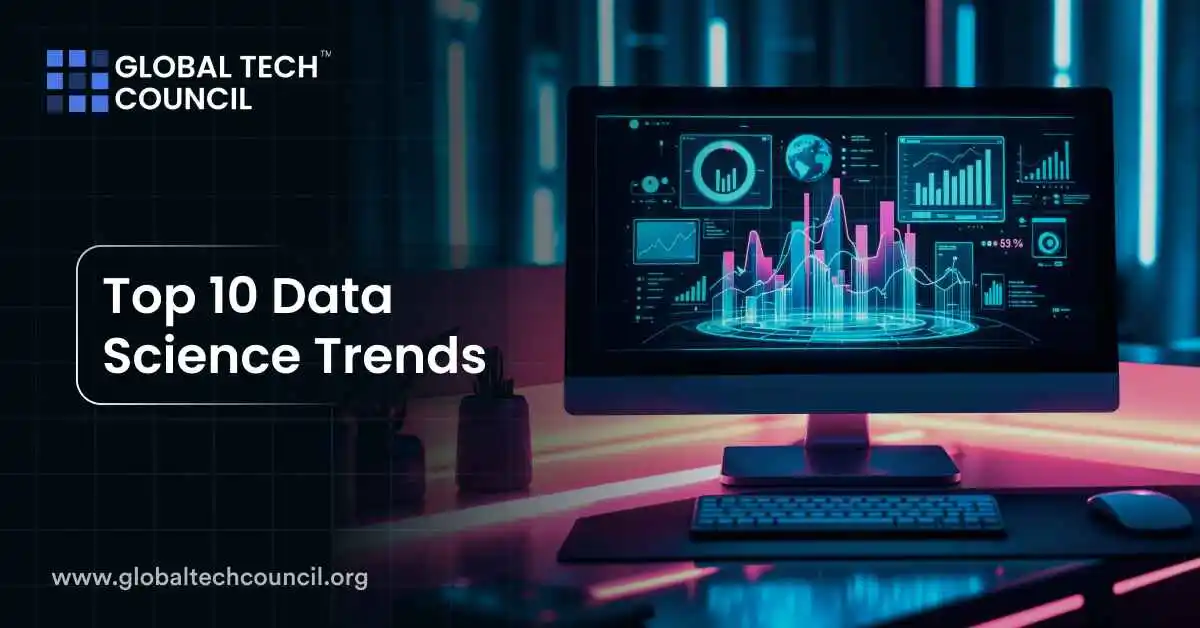 The top 10 data science trends in 2025 are: Agentic AI, AutoML, Synthetic Data, Federated Learning, Augmented Analytics, Real-Time Analytics, Edge AI, Explainable AI (XAI), Data-Centric AI, and Data Democratization. These trends are reshaping how data is collected, processed, and used across industries.
The top 10 data science trends in 2025 are: Agentic AI, AutoML, Synthetic Data, Federated Learning, Augmented Analytics, Real-Time Analytics, Edge AI, Explainable AI (XAI), Data-Centric AI, and Data Democratization. These trends are reshaping how data is collected, processed, and used across industries.
In this article, we’ll walk through each trend, explain what it means in plain English, and show why it matters to professionals, teams, and businesses working with data.
1 Agentic AI
Agentic AI is a new type of AI that doesn’t just follow instructions — it takes initiative. These systems can plan tasks, make decisions, and even talk to other AI agents without human input.
In data science, agentic AI is helping automate workflows, clean data, and even run experiments independently. This makes projects faster and less dependent on manual effort.
2 AutoML (Automated Machine Learning)
AutoML helps you build machine learning models without writing lots of code. It handles tasks like selecting algorithms, tuning hyperparameters, and validating results.
In 2025, AutoML tools are becoming smarter and more user-friendly. Tools like Google AutoML and Microsoft Azure AutoML are now being used by marketers, business analysts, and HR teams — not just developers.
3 Synthetic Data
Synthetic data is fake data that looks real. It’s used when the real data is sensitive, private, or simply unavailable.
For example, hospitals can train models on synthetic patient records without risking privacy. In 2025, companies are using synthetic data to speed up AI development and reduce bias in training datasets.
4 Federated Learning
Federated learning allows companies to train machine learning models without sharing raw data. Instead, the models learn locally on each device or server and only share the learned patterns.
This is especially helpful in industries like finance and healthcare, where privacy is critical.
5 Augmented Analytics
Augmented analytics uses AI to make data analysis easier for non-technical users. These tools automatically suggest insights, create visualizations, and even ask and answer questions about the data.
Tableau, Power BI, and Qlik Sense now include augmented features that allow users to explore data without writing code.
6 Real-Time Analytics
Real-time analytics means analyzing data as it arrives — not hours or days later. It’s used in fraud detection, e-commerce, and monitoring systems.
In 2025, companies expect real-time alerts and dashboards as a standard feature, not a luxury.
7 Edge AI
Edge AI is AI that runs directly on devices like smartphones, cameras, or sensors — not in the cloud. This reduces delay and improves privacy.
In industries like logistics, smart cities, and autonomous vehicles, edge AI helps make faster, safer decisions using real-time data.
8 Explainable AI (XAI)
AI is powerful — but it often acts like a black box. Explainable AI helps people understand why a model made a certain prediction.
This is important in fields where trust and transparency are critical, like healthcare or banking. In 2025, many companies are required by law to show how their algorithms work.
9 Data-Centric AI
Instead of just focusing on better models, data-centric AI focuses on improving the quality of data. Clean, labeled, and balanced data leads to better models — even without changing the code.
This approach is gaining popularity because it’s often cheaper and more reliable than endlessly tuning algorithms.
10 Data Democratization
Data democratization means giving more people access to data — not just analysts or IT. It’s about tools and cultures that make data easy to explore, understand, and act on.
Self-service dashboards, natural language queries, and better training are helping companies become more data-driven across departments.
Why These Trends Matter Now
In 2025, businesses can’t afford to treat data science as a back-office function. These trends are shaping how companies launch products, understand customers, manage risks, and innovate faster.
Understanding these trends helps you:
- Build more accurate models with less effort
- Keep up with privacy laws and AI ethics
- Choose the right tools for your team
- Future-proof your career in a fast-changing space
If you’re looking to upgrade your skills, a hands-on Data Science Certification is a good place to start. It covers key tools and use cases aligned with these trends. And if your focus is business decision-making, branding, or digital strategy, a Marketing and Business Certification connects data science to ROI and market outcomes.
To go deeper into advanced technologies like blockchain, AI agents, or Web3, explore programs under Deep Tech certification — available at Blockchain Council.
Final Thoughts
Data science in 2025 is smarter, faster, and more accessible. Whether you’re in healthcare, marketing, finance, or logistics — these 10 trends will likely affect how you collect, clean, and use data.
You don’t have to follow every trend. Start with the ones that match your current work. Learn the tools. Apply them to real problems. And stay curious — because the next big shift in data science might just be around the corner.